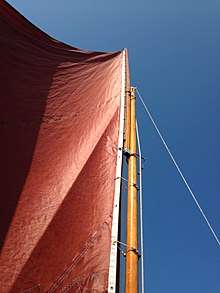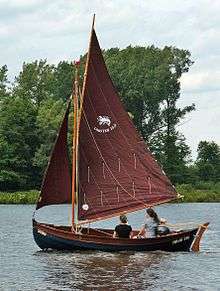Gunter rig
Gunter rig is a configuration of sail and spars used in sailing. It is a fore and aft sail set abaft (behind) the mast. The lower half of the luff (front) of the sail is attached to the mast, and the upper half is fastened to a spar which is approximately vertical and reaches above the top of the mast. This spar is called a "yard", but it is common for some to confuse it with a "gaff" (as in Gaff rig).[1]:38 The overall shape of a gunter sail is roughly triangular, so having a superficial resemblance to Bermuda rig.
A gunter sail may also be called a "gunter lug" - a name which suggests developmental origins from increasing the angle of a high peaked standing lug.[2]:91 Gunter sails are sometimes described as "sliding gunter".[3]
Gunter rig is generally used in small sailing craft. One important advantage is that the shorter mast used with this rig usually fits within the hull when unstepped, together with the boom and yard. This is helpful for a dinghy that is towed behind a car, stored in a garage, or used as a tender for a larger boat. The performance to windward comes close to that of Bermuda rig.[1]:38[2]:91 Gunter rig can be found in a few working craft, but the majority of uses are in pleasure craft.[lower-alpha 1]
There are many variations of gunter rig: the most fundamental of which include whether the sail is hoisted with one or two halyards, and the ease with which reefs can be taken in.
Operation
In what follows, broadly speaking, the 'single halyard' sail is known as a "sliding gunter," while the 'double halyard' sail is a "folding gunter." The sliding gunter yard stays essentially vertical while being raised, while the folding gunter is 'hinged' up to the mast from the horizontal, much like a high-peaked gaff sail.
Although the term yard is normally employed to name a spar which crosses a mast, and gaff one which is fastened to the mast at its forward point — as it is in the case of the gunter rig. However, since the gunter rig is derived from lug rigs - where the spar from which the sail hangs is always called the yard, rather than from gaff rig - despite the similarity between a high peaked gaff rig and a gunter rig, the spar can be called a gaff or a yard.

Single halyard
- fix the gaff loosely to the mast in a vertical position, parallel to it, with either hoops or parrel beads so that it will slide freely to the desired height, and ensure that the sail is bent to the gaff.
- secure jaws of the gaff around the mast with parrel beads if the gaff is a jawed gaff, or rely on the hoop if hoops are employed.
- bend the throat halyard to the jaws
- haul the jaws up the mast until the desired height is reached and make fast
- using whatever reefing mechanism you have, usually reefing points, reef any excess sail at the foot to the boom (if any) or gather the belly of the sail if loose footed.
Even with a single halyard the hooped gunter is a vertical sliding gaff
Double halyard
One halyard, the peak halyard, has a block, sometimes just a shackle, that allows the gunter (wire parallel to the gaff and fixed to it at two points on its upper (or leading) surface) to raise the gaff into the vertical position up against and parallel to the mast. The other, the throat halyard, is used to raise or lower the jaws of the gaff.
The mode of operation is:
- bend the peak halyard to the sliding device on the gunter
- bend the throat halyard to the jaws
- secure the parrel beads around the mast from jaw to jaw to locate the jaws positively around the mast
- haul the gaff into the vertical with the peak halyard and make fast
- haul the jaws up the mast with the throat halyard until the desired height is reached and make fast
- using whatever reefing mechanism you have, usually reefing points on larger vessels, reef any excess sail at the foot to the boom (if any) or gather the belly of the sail if loose footed.
- adjust the tension in the luff of the sail by adjusting the throat halyard, downhaul, gooseneck or any combination of these.
Reefing

Reefing a gunter rigged boat with a single halyard requires the sail to be lowered and (usually) the halyard repositioned on the yard or (rarely) the sail to be moved downwards along the yard. However some gunters have a second halyard from the end of the yard, to hoist the sail once the yard is hoisted; these are gunter rigged but have borrowed traits of the Bermuda rig. The yard is hosted fully and then left in position and regarded as a semi-permanent topmast, with the sail raised or lowered as required.
See also
Notes
References
- Barnes, Roger (2014). The Dinghy Cruising Companion: tales and advice from sailing in a small open boat (Kindle ed.). London: Adlard Coles Nautical. ISBN 9781408180273.
- Leather, John (1979). Spritsails and Lugsails (1989 reissue ed.). Camden, Maine: International Marine Publishing Company. ISBN 0877429987.
- Nichols, David L. (2006). "Chapter 4: The Sliding Gunter - A Versatile Traditional Sailing Rig". The Working Guide to Traditional Small-Boat Sails (Kindle ed.). Halcottsville, NY: Breakaway Books. ISBN 9781891369674.
- Ansel, Willits D. (1978). The Whaleboat: A Study of Design, Construction and Use from 1850 to 1970. Mystic Seaport Museum, Incorporated. ISBN 0913372390.
External links
| Wikimedia Commons has media related to Gunter rig. |